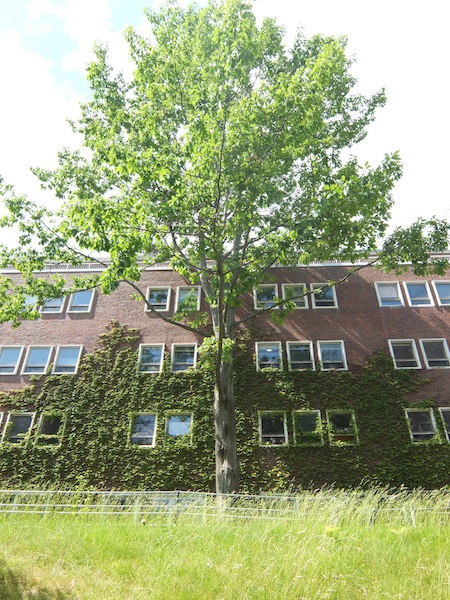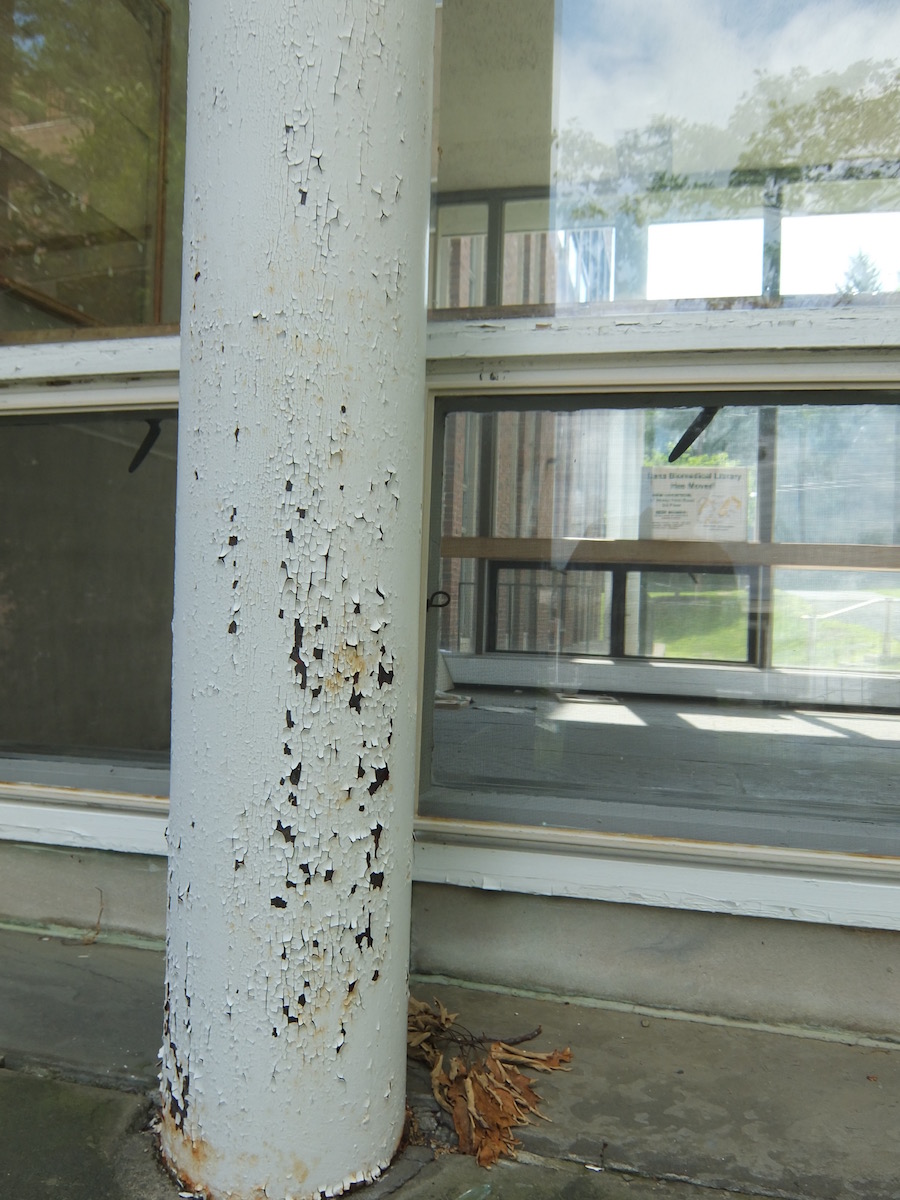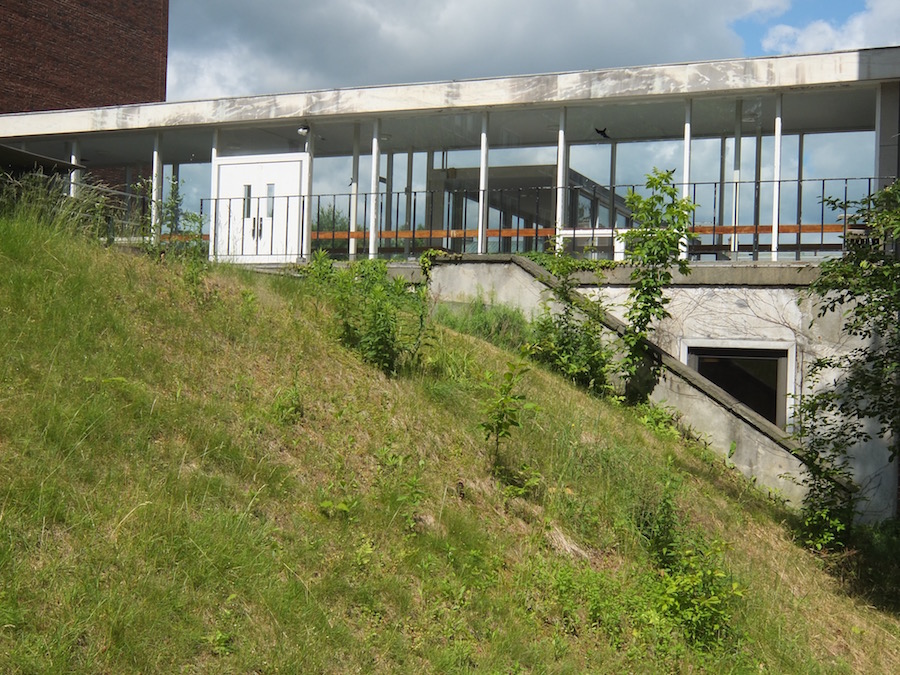The 638-bed apartment complex in Lebanon known as Summit on Juniper began accepting residents in August (Dartmouth News, The Dartmouth). The complex is a joint project of the college and Michaels Student Living.
Category Archives: Med. School
More observations about the final strategic master plan
The college released the final (November 2020) version of the master plan (pdf) in July of 2021 (Anna Merriman, “Dartmouth master plan calls for growth along Lyme Road,” Valley News (2 July 2021)). The plan is not getting enough press or enough praise, so here are some observations:
-
As noted earlier, the possibilities for growth in the central campus look great (page 38).
-
The north end opportunity sites are all super. Old Hospital Quad will be an incredible space 130 years in the making (pages 42-43). Fairchild Tower always did seem more than necessary for its purpose; it is really a signpost building (pages 44-45).
-
Putting student housing in Remsen-Vail might be touchy. If you wanted to reuse a dull Sixties building as housing, you should have done it with the DHMC tower. Remsen-Vail could be appropriately used for academic purposes, however (page 44).
-
Lyme Road development is inevitable, but it is not clear how realistic it is to show such development without parking lots (pages 46-47).
-
When it comes to the West End, the novelty in this plan is the meander of the Cemetery Bridge (Thayer Viaduct). It is more like a boardwalk on a nature trail and does not appear to be a suspension bridge at all — but won’t it be extremely difficult to put bridge footings in a cemetery? (Pages 48-49).
-
More on the West End: Again, the original Tuck School building here could make an amazing undergraduate dormitory, but one would hate to see Tuck School vanish into the suburbs (pages 48-49).
-
South End and Downtown: The athletics promenade between Lebanon St. and Thompson Arena is excellent and long overdue. It could be a fine linear work of landscape architecture. Annexing Davis Varsity House as a part of the “house community” for the Crosby Street swing space dorm could be a superb move. The reasoning behind the focus on wellness for an expanded McKenzie is not clear — couldn’t it be used for anything, including arts uses? — but it makes no difference as long as the building is saved. McKenzie might present a real opportunity to create a new building within the historic brick walls (pages 52-53).
-
Quibbles are minor and basically the same as before: Thayer School didn’t go from the old Experiment Station directly to the West End in 1939, it spent several years in Bissell Gymnasium (page 9); the reference to “Dart Hall” is kind of irritating (page 38); and it’s “Bema” not BEMA (page 41).
-
The map on pages 28 and 29 showing named landscape opportunities is an important document. Some offhand proposals for these spaces:
Name in Plan Proposed Replacement Riverfront Park Leydard Park West End Green A tough one; this was the Wigwam Circle postwar housing area. Tuck Green at the end of Tuck Mall Tuck Circle Dart Row Commons Fayer Green? “Commons” is not really appropriate for an open space. Maynard Yard Old Hospital Yard. This really is a better name. Life Sciences Lawn Another tough one; there is very little historic context here. North End Green in a strip of Dewey Field Dewey Field. Another one that really is a better name. Vox Lane NHCAMA; New Hampshire something; or State College something? “Vox Lane” has always been arbitrary, which is disappointing in this richly historic precinct. Park Street Gateway Piazza Nervi. This is tougher to justify now that grass rather than hardscape is proposed for this space.
Dartmouth Unbuilding and other topics
-
The smart brick rear ell of Wheelock House, a century-old two-story-above-basement book stacks addition built for the Howe Library, was demolished last month by the Eleazar Wheelock Society.
-
Commencement this year took place at Memorial Field for the first time since 1995. The stage was at the opposite end of the field this year. It would be interesting to learn whether the Commencement canopy is the same one that was first acquired for that 1995 ceremony and has been used every year since. Perhaps there have been different ones.
-
Frank J. Barrett’s new book is called Lost Hanover, New Hampshire (Amazon.com). Julia Robitaille has a Q and A with the author in The Dartmouth (2 July 2021).
-
The Dartmouth Indoor Practice Facility is now the Graham Indoor Practice Facility.
-
Photos of the CECS show it really taking shape. The Irving is also coming along. The Call to Lead has a page on new projects on campus that includes a West End video showing interior models of the two buildings (as well as close-ups of the globe finial following the removal of Baker’s weathervane).
-
DHMC Patient Tower, an appealingly midcentury hospital building by HDR (designers of The Williamson), is slated to stand at the north end of the hospital and join the main building between the bastions of the existing patient towers (Vermont Digger). The site is visible at the right of this iconic aerial.
-
At the trustees’ meeting in June, “[t]he board approved the expenditure of $2.89 million to advance designs for energy infrastructure projects and $1.65 million to support campus housing renewal design development. Board members also voted to allocate $6.9 million for information technology infrastructure work.”
-
The college website is being redesigned (Dartmouth News).
-
The IEEE has put up a plaque on the exterior of Collis (College Hall) to commemorate its importance as the site where BASIC was developed in the 1960s (Dartmouth News). The plaque would be better if it were actually written as a BASIC program, thus proving the simplicity of the language, but this is still good to see. (The BASIC highway marker, because of the limitations of the state’s marker program, is distant from the site where the event actually took place.)
-
Harvard Law School has replaced its old heraldic shield with a new shield in the form of a logo.
———–
[Update 09.13.2021: A reference to a “new” globe finial replacing the Baker weathervane has been corrected. The globe previously underpinned the weathervane and was left in place when the weathervane was removed.]
Insignia
Office of Communications, “Working Group Will Outline Best Practices for Iconography” (6 May 2021):
The Campus Iconography Working Group has begun work to draft recommendations for artwork, images, and nomenclature across Dartmouth’s physical and digital environments. The group, which includes students, faculty, staff, and alumni, will consider items such as paintings, sculptures, statues, and official insignia.
Contrast that project with the recent OCD overhaul of Dartmouth’s visual identity on an essentially graphical basis.
It seems likely that the group will recommend the retirement of Dartmouth’s 1944/1957 coat of arms, the familiar shield depicting a pair of Native Americans walking toward a college building (not Dartmouth Hall but a generic college or, at best, a Dartmouth Hall precursor).
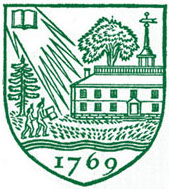
Jonathan Good’s Proposal for a Heraldic Coat of Arms for Dartmouth College anticipated this retirement decades ago and suggested an appropriate replacement.
It is important that Dartmouth, while retiring its current coat of arms, create a replacement coat of arms. There is a risk that the college will do nothing and that the D-Pine, a fine less-formal symbol particularly suited to athletics (notwithstanding its description by the Office of Communications as “the most formal brand mark”) will become the official symbol of Dartmouth College.
Any iconography decision will apparently not affect the naming of the Geisel School of Medicine (Inside Higher Ed).
Dartmouth NEXT, a sort of Great Issues for the world, uses the map (or really the pattern) of paths on the Green in a graphical way to form a right-pointing arrow logo:

A course exhibit from April 2020 titled The Indian Symbol at Dartmouth: A Story of Voices and Silence contains a number of notable documents from the archives. The 1932 article on “the new official insignia,” for example, is very interesting and brings to light an obscure design. One note: The Eleazar Wheelock Tombstone, which is carved (not stamped) with a version of the Indian head symbol, is actually a non-funerary monument located in Columbia, Connecticut. Wheelock is buried in Hanover, N.H.
Hilton Field as a sculpture park
Here is a thought: What if, instead of calling for an arboretum on the former golf course, the master plan (see the post here) proposed to construct a large sculpture park? A sculpture park on Hilton Field, the part of the golf course that lies north of Occom Pond, would have little more impact on the neighbors than would an arboretum. It would be managed by the Hood Museum as a site for major new works, and it could provide a home for any refugee works that the college thought appropriate to move from the campus, such as Thel (see the article here; the master plan at least hints at the possible removal of Thel).
Speaking of Thel, here is William Blake’s new gravestone in Bunhill Fields Burial Ground in London. It was created by the Blake Society under the leadership of Philip Pullman, of His Dark Materials fame.
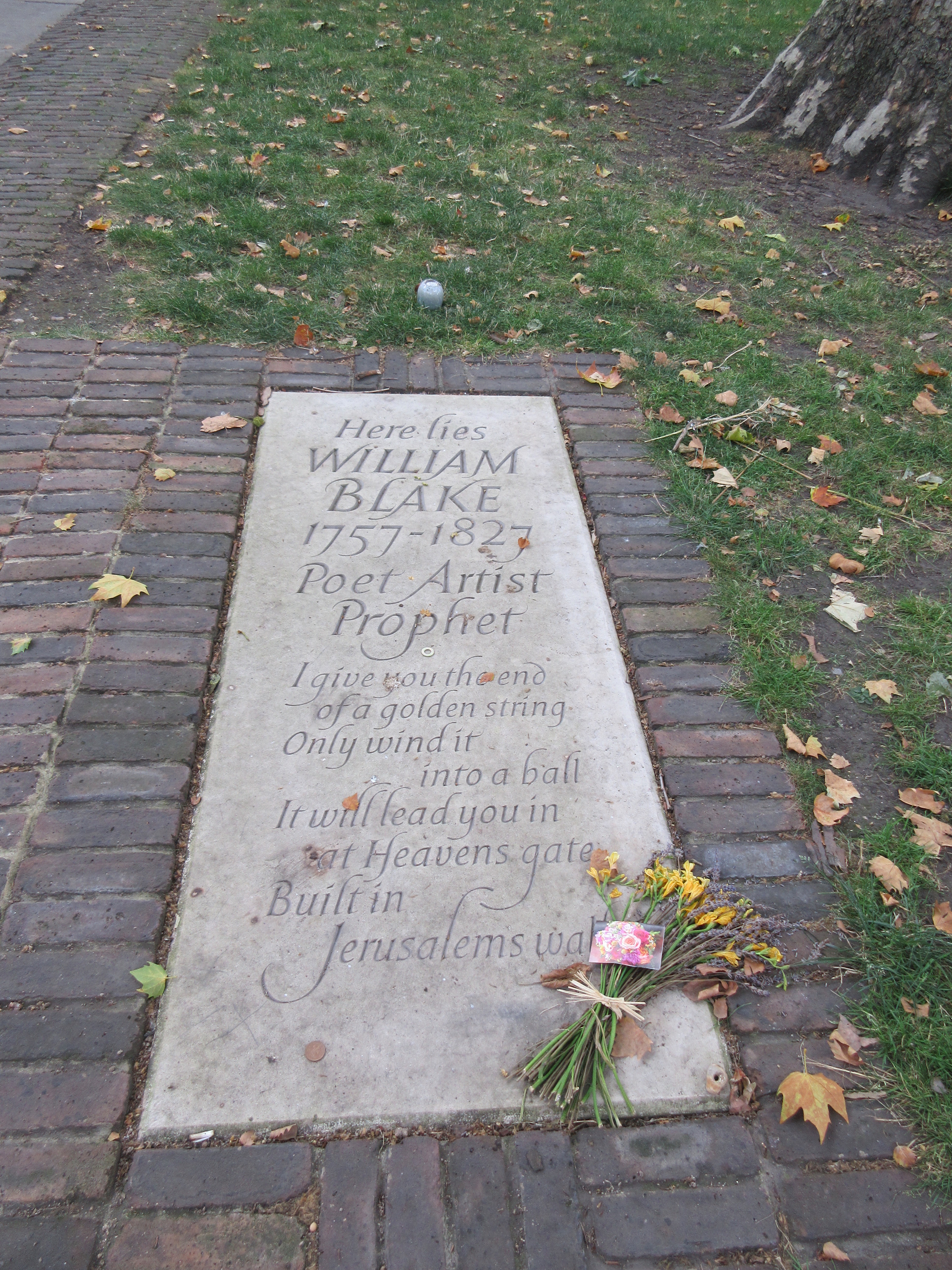
The Anonymous Hall bridge (see photos at the Windover Construction site) deserves praise for adding to the walkability of the northern part of the campus. It seems like the sort of amenity that could easily be cut from a construction budget.
Let’s hope the proposed cemetery bridge (see the final image at the BBB master plan project page for a conceptual view) eventually is built, and when it does cross the burial ground, let’s hope it receives an appropriate amount of design attention. What a fantastic project this could be, and what a great opportunity for an architectural commentary on the influence of ancient Egypt on both bridges and funerary architecture. See for example the post here for a proposal to erect an ominous cemetery gate at each end of the bridge.
Egyptian Revival architecture makes for a good folly; authors Gwyn Headley and Wim Meulenkamp have a new book out called The English Folly: The Edifice Complex. Their earlier book, Follies: A Guide to Rogue Architecture in England, Scotland and Wales, features a photo of the Dunmore Pineapple in Scotland (Wikipedia) on its cover. Yes, that Dunmore: the building’s patron, John Murray, was the Governor of Virginia at the beginning of the Revolution. On December 6, 1775, Murray wrote to (that) Lord Dartmouth to say that “I immediately ordered a Fort to be erected” at Great Bridge, on the edge of the Great Dismal Swamp (pdf, 1311). The utilitarian and hastily-built timber stockade called Fort Murray was pretty much the opposite of a folly; it withstood a rebel siege but no longer exists.
The master plan: further reactions
See the previous post on this topic.
The two locations of Geisel
The new-look Remsen/Vail at the north end of campus is an improvement and looks like the work of Leers Weinzapfel Architects, the designers of the reskinned Dana Library/Anonymous Hall adjacent (page 44 of the plan).
Remsen-Vail
If the Geisel School of Medicine were to relocate to new facilities, this opportunity for adaptive reuse can accommodate up to 550 undergraduate student beds and/or academic space, and could include new facade materials, enlarged windows, and a welcoming new entrance.
One might have no particular objection to the architecture but still recoil at the idea of placing undergrad beds or academic space this far away from the center. Undergraduate uses do not belong this far north. As a ten-year swing space allowing the rehabilitation of other dorms, perhaps, but it is just too far away.
The larger point here is that Geisel seems uncertain about its location. That the school is split between its traditional home here at the north end of campus (including its fancy admissions office in a renovated 19th century hospital ward) and its technical and efficient home alongside the suburban hospital south of town has always seemed strange. Students begin their education in Hanover and conclude it at the hospital in Lebanon.
Whether this split the result of intention or of nothing more than the lack of a replacement for Remsen/Vail at the DHMC campus, the plan suggests that Geisel could leave Hanover and make its DHMC site a true and complete med school campus. If that happens, it would be hard to argue that the vacated Geisel buildings in Hanover should not be used by Dartmouth (although a similar argument was successful in the past, when most of the hospital complex was demolished; VSBA had suggested that the Modernist main tower, at least, be renovated as a dormitory).
The proposals for a med school campus at the south end of the DHMC complex are so sensible as to raise the question of why they have not been built or at least planned already. A main building, some housing, and a modest green space for a medical school? Perhaps it is a measure of the committed suburbanity of the hospital complex that such a thing has not been accomplished thus far. The Geisel campus can grow as a grid of independent buildings flanking outdoor spaces rather than as the nucleus of a radiant sunburst of parking lots.
The Grand Limited-Access Road
New limited-access roadway for shuttles, emergency vehicles, and bicycles connecting Sachem Village and DHMC.
The transit link across the woods between Sachem Village and DHMC stands out as completely obvious and necessary, even to someone who knows the area only from maps.
Is the access limitation placed on the road because it goes through the residential neighborhood of Sachem Village? If there were some way to make it a proper road, it could take a lot of pressure off downtown Hanover. Yes, limited-access streets are pleasant and necessary — perhaps South Main Street above Lebanon Street? — but preventing this road from handling traffic seems cruel to Hanover.
The future has already arrived in the West End
Not much is novel here because there are two major buildings currently under construction. The rest of the area, while populated with buildings from the Sixties and Seventies, is still something of a blank slate. West End Green might be a bit vague (trees will do that) but it is an improvement.
Speaking of the Tuck School, it always seems to be threatening to leave:
In the future, the Tuck complex could be renovated and expanded to advance its competitive edge. Or, if relocated to new facilities, Woodbury and Chase, originally built as student housing, as well as Tuck Hall could be repurposed for undergraduate
housing, providing up to 230 beds.
Putting undergrad beds in the Tuck complex would be a neat trick, but moving Tuck out to some shiny, flimsy complex at an isolated forest site in Lebanon would be a blow to Dartmouth.
Does the college need to give a territorial guarantee to keep Tuck on campus, perhaps a promise of a portion of the future sites around West End Green and an access corridor or exclave on West Wheelock Street, a B-School Kaliningrad?
Minor points
-
What is the unlabeled property to the northwest on the map on page 5? It is the college-owned woods in Corinth, VT (see page 60).
-
The Covid-19 information in the master plan makes for a timely preface but already seems a bit dated in this 30-year plan.
-
“Gibson” is spelled “Givson” on an image on page 36.
-
“Hanover Campus” is inconsistently capitalized. The version with a lowercase “c” seems preferable.
-
Calling it “the College Park BEMA” is odd. There is no other Bema to confuse it with, so “the Bema” or “the Bema in College Park” would suffice. And “BEMA” does not need to be in all capital letters — the word “BEMA” in caps is a backronym (a back-formed acronym) for Big Empty Meeting Area, and as such makes a cute campus legend, but the Greek-derived word after which this space is named is “Bema.”
-
Is it strange to call it “Mount Moosilauke Ravine Lodge”? The mountain is Mt. Moosilauke and the lodge seems like it should be called the Moosilauke Ravine Lodge.
-
The map on page 9 showing new nodes hopping around campus is neat and insightful, but it could make its point even more strongly if it showed Thayer School’s time in Bissell Gym (on the Hop plaza, basically) from 1912 to 1939. And if the map substituted Geisel for MHMH, it could show three nodes instead of two: first the Medical School (on the Burke Lab site, from 1812 to the 1950s[?]), then MHMH, then the hospital complex in Lebanon.
Symbols, including weathervanes and flags
Baker Tower Weathervane. The Valley News has been reporting on the petition calling for the removal of the Baker Tower weathervane and the college’s plan to remove it (see also Dartmouth News). A crane crew removed the weathervane on June 25 (Dartmouth News).
The college plans to create a replacement; George Hathorn has suggestions. The June 25 Dartmouth News piece by Aimee Minbiole states that “Vice President for Communications Justin Anderson will assemble a working group to consider designs for a new weather vane and whether other changes in iconography across the institution are necessary.” If that iconography includes the college seal with its depiction of Native Americans, one solution would be to adopt an heraldic seal based on an heraldic coat of arms.
The cascading effects of the weathervane’s deprecation are interesting. The Guarini shield, less than a year old, contains the tiniest imaginable depiction of the weathervane, but it will apparently be changing. (It is even less visible than the Indian head cane that was removed from the pre-2012 DMS shield.) The Town of Hanover is also changing its official logo, which contains a line drawing of Baker Tower that also features a small version of the weathervane. Remarkably, the Valley News story, citing Town Manager Julia Griffin, states that some variants of the town logo already render the two human figures as trees: “Griffin said via email that many of the logos in town show three pine trees on the weather vane, rather than the more troublesome figures. For now, those logos won’t be changed, she said.”
The original 1928 copper exterior of the Baker Tower weathervane is already in storage. The exterior was recreated, according to the Valley News story of June 12, as part of the tower renovation project of 2016, less than four years ago. Compare that missed-opportunity-in-hindsight to the travails of U.Va., which updated its athletics logo in April and two months later finds itself tweaking the new design to get rid of the twisted hilts of the crossed sabers. What is the symbolic significance of a twisted hilt? It is not clear that it has any independent meaning at all, but the promotional verbiage that was put out with the spring update pitched the twisted hilts as a reference to the serpentine walls that line the back gardens of the university’s original buildings. Those walls’ connection to enslavement is the prompt for the latest change.
(One would think that the bigger problem is the association with the Confederate cavalry saber — the crossed, curved cavalry sabers are much more typically seen as an emblem on a mid-19th century slouch hat than in connection with a 17th-century cavalier — but the designer of the U.Va. logo in the mid-1990s says he did not intend it to refer to the Civil War.)
Flags. A lot is going on with flags these days. Mississippi has dropped its flag and will consider the Stennis Flag among the possible replacements. The 9/11 “Freedom Flag” (spotted in the wild here) is the subject of a bill, sponsored by Reps. Spanberger and King, proposing to make it the official flag of 9/11 remembrance (WTVR News). The flag is to be flown on federal buildings from September 11 through 30 each year. Finally, CNN has a piece on the Juneteenth Flag. Maybe looking at the Freedom Flag encourages one to view every flag as a map, but the zig-zag “burst” lines on the Juneteenth Flag can also be read as the plan of a 19th-century star fort. One might prefer a version of the date that omitted the comma, but the specificity of putting the date on the flag in words is appealing.
Other symbols, including plaques. There is an official climate emergency tartan (Scottish Register of Tartans). The FCC has a new seal (see Brand New, also FCC announcement pdf). The eagle has post-Homeland Security wings; the antenna feed line, which curved realistically in the old FCC seal, is made into a rigid line of division of the shield — ouch.
Finally, because this site is always on the lookout for a rogue plaqueing, a link to Kevin Levin’s Civil War Memory post on the series of unofficial historical markers erected by activist historians on Monument Avenue in Richmond. Some of the markers apparently have been ripped up already (WTVR News). Three of the four city-owned statues of defeated rebels have been removed in recent days, and only Stuart remains. Here is a windshield snap taken yesterday; the statue is not expected to last another week. It does feel like Europe in 1989:
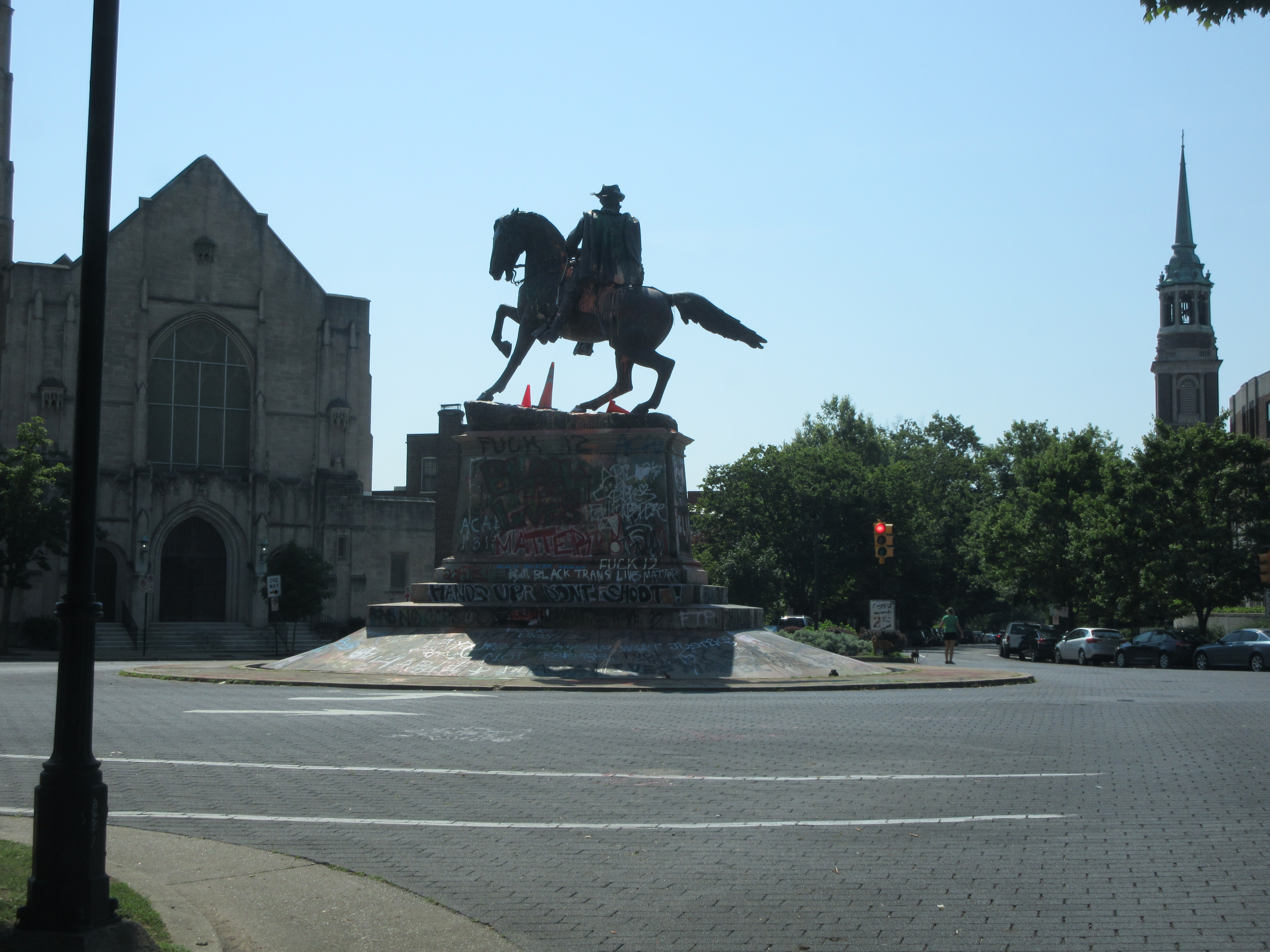
Crosby Street dorm off the table and other news
- The construction of the Indoor Practice Facility is nearly finished (see Big Green Alert). The school’s existing indoor practice facility, Leverone Field House, is being eyed as a site for a temporary hospital ward during the pandemic (Valley News). The west wing of Alumni Gym is also under consideration (Valley News).
- This interesting tidbit appeared at the end of a board news release about new trustees:
The new board members were elected at the board’s spring meeting, held this year at Stanford University in Palo Alto, Calif.
That seems like a first. The main news release (issued 1 March) has more information:
The board met at Stanford University in Palo Alto, Calif., where they engaged in wide-ranging conversations with a diverse group of Stanford leaders including trustees, the former and current presidents, the provost, faculty in leadership positions, and representatives from departments across campus.
Not sure what to make of that, whether the learning opportunities were added to enhance the remote meeting or the meeting was held on the other side of the continent specifically in order to learn from Stanford.
- Shattuck’s Revenge. At the Stanford meeting, the board approved a capital budget to fund projects that include “include renovation of Thornton Hall; planning and design of the Dartmouth Hall renovation; planning for proposed projects with private developers, including graduate housing and energy infrastructure; and” other projects. An interesting mention is made of $3 million “for planning and schematic design to explore the renovation and expansion of the Choates residence halls and the East Wheelock residential complex,” and funding for the future Hop renovation (still on the table!) and construction of teaching and research spaces is also noted. Not a word, however, on the Crosby Street dorm, which has been in planning for more than two years now. The project page for the design of the building was quietly removed from the Campus Services website during the last few weeks.
- Irving Oil Co. has a rendering of the Irving Institute that differs in detail from the other images out there.
- The college launched its capital campaign two years ago at Duggal Greenhouse in the Brooklyn Navy Yard. Some photos from the event show considerable attention to detail: the use of Dartmouth Ruzicka lettering on the front facade; the model (15′ high?) of the bonfire, reimagined as a cocktail table; and the plaster/pasteboard renderings of Baker Tower and the main buildings of Tuck, Thayer, and Geisel (it’s white, but it’s a reasonably accurate rendition of the school’s ex-hospital building on Maynard Street).
- Unrelated even to architecture: Although it is not unusual to hear of a company that has been operating since 1905, it is unusual to find one that has been making the same product since its beginning. How odd would it be if that product were a Morse code key? Take a look at Vibroplex and its Original Standard key. This is not quite an example of Ferry Porsche’s theory that the last car ever to be built will be a sports car (see Porsche’s site), because the FCC seems to effectively subsidize the use of Morse Code by prohibiting other modes of communication on certain radio frequencies, but it is close.
The fine line between clever and stupid
- A new site plan for the new dorm by the gym shows some refinement. The “bridge” element facing Crosby Street looks like the main entrance and responds to what planning analyses have identified as a major pedestrian route — the parking lot of the Heat Plant and Vox Lane. That’s nice, and one hopes the emphasis on this route helps cement the place of McKenzie and the Store House. But a good percentage of visitors to the new dorm will be arriving at the front of the building, at the Wheelock Street corner. No path is shown there. The construction timeline states “Commence Completion of Design phase – dependent on fundraising.”
- Dana Biomedical Library, reconstructed as Dana Hall, has been renamed Anonymous Hall (Dartmouth News, Valley News). Unlike, say, Nameless Field at U.Va., the building does not lack a namesake; its namesake is simply undisclosed. What would be an unfunny move if committed by the administration might be saved by the fact that it was requested by the donor of the renovation. The Guiarini School (formerly the School of Graduate and Advanced Studies) is headquartered in Anonymous Hall. The building contains a DDS cafe called Ramekin Cafe.
- More Irving renderings are available and a time-lapse video of construction is on line.
- Dartmouth Ruzicka is being rolled out on the school’s websites, a December article explains.
- Berry Mall has been torn up as part of the project to extend utilities to the west end of campus.
- The maples on the south end of the Green are coming down. They did always seem a bit diminutive for the space; too round in comparison to the elms, or something.
- An article in The Dartmouth explains the Fifty.
- A well drilled on the Green is being tested for use in a geoexchange system like the one in use at Fahey-McLane.
- A Valley News article on the projected library storage building.
- Lawrence Biemiller has a bit on the Hood in a post on lessons that campus buildings have taught.
- The college is in a partnership with a developer to build hundreds of apartment units for graduate and professional students near the hospital (Union Leader, Dartmouth News). It is hard to imagine how this could be anything but sprawl, but we will see.
- BGA Daily has photos of the indoor practice facility. It looks like the renderings! One does hope that the building will connect to the brick gateway of Scully Fahey Field, although it looks doubtful. There is a curious kind of preservation going on with the brick pier of the Boss Tennis Center: BGA Daily photo.
- An article on the new painting at the Skiway.
- Rauner Library has an exhibit on slavery at Dartmouth.
- The Reed Hall renovation designed by EYP is beginning (Dartmouth News).
- Some U.Va. students are saving the old card catalog that was being removed from the main library building (Washington Post), and the U.Va. administration is starting a campaign of plaques, markers, and tours focused on the history of the institution.
- If you enjoy Kate Wagner’s McMansion Hell, you’ll enjoy her “Duncing about Architecture” in the New Republic, about a proposed executive order titled “Making Federal Buildings Beautiful Again.” The group behind the proposed order, National Civic Art Society, counts the founder of Joe’s Dartblog among the members of its board of directors.
———-
Update 02.09.2020: NCAS item added.
A tree tour of campus
-
Dartmouth News writes on the Gilman demolition and Dana renovation.
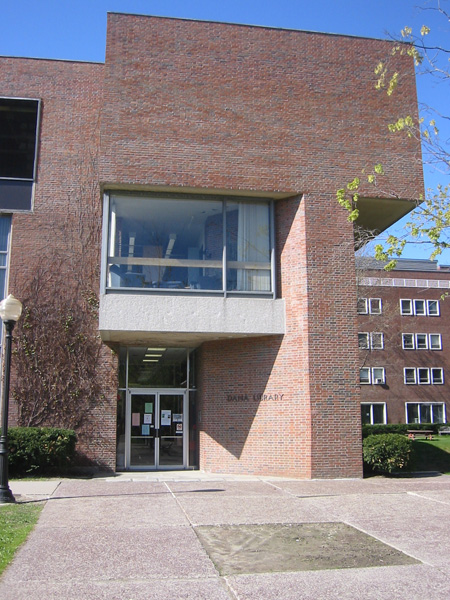
Dana Library entrance -
The bench at Lebanon and Crosby is a puzzling object; it was being examined by two people when the Bing StreetSide View car drove by.
-
The Valley News:
Trustees also reviewed designs for a building to house the Arthur L. Irving Institute for Energy and Society, a new interdisciplinary initiative launched with an $80 million gift from the family behind Irving Oil.
Lawrence declined to share the designs publicly, saying they were “highly preliminary.”
Administrators in regulatory filings earlier this year discussed building a $73 million structure at the end of Tuck Mall, on the west end of campus.1 Rob Wolfe, “Dartmouth Readies Fundraising Push,” Valley News (19 September 2017). -
Dartmouth News has a neat film on the Campus Arborist with footage taken by a drone flying up into the canopies of some of the grand trees on campus. There is a link to an interactive map of notable campus trees.
-
The monthly Enterprise magazine, a Valley News publication, has articles on the Trumbull-Nelson centennial and the Hanover Improvement Society.
-
One thing that a reader might want to learn after reading Alan Burdick’s interesting New Yorker article on watermelon snow is how watermelon snow actually tastes. It tastes like watermelon.
-
The county court has upheld the town’s rejection of the college’s proposal for an indoor practice facility or fieldhouse in the Sunken Garden (Valley News).
-
The new Moosilauke Ravine Lodge is opening October 14.
——————
| ↑1 | Rob Wolfe, “Dartmouth Readies Fundraising Push,” Valley News (19 September 2017). |
|---|
President for the time being
-
A task force is exploring the possibility of expanding college enrollment from about 4,310 to as many as 5,387 (press release, Inside Higher Ed). Maybe that’s why the Golf Course land is so appealing.
-
Freeman French Freeman has a rendering and a plan of the expansion of the Sports Pavilion out at Burnham Field (FFF brochure). The building is still not named after anyone. The rendering shows some lettering on the side of the building: DONOR PAVILION.
-
Morton Hall, a building in the East Wheelock Cluster, has opened again after it was damaged in a fire (press release). The building was gutted and a new interior was designed by Harriman Associates of Portland, Maine (Harriman).
-
The timber-framed picnic pavilion has opened at the Organic Farm (Dartmouth News).
-
An old railroad station in West Lebanon has been moved (Valley News).
-
Dana, once on the chopping block, is being renovated by Leers Weinzapfel Architects of Boston,
authors of some great chiller plants and the huge UPenn athletic field complex of Penn Park (with MVVA).
Dana is expected to be ready in the fall of 2019. Gilman will be demolished by the end of this year (Campus Services). -
The Class of 1967 Bunkhouse has opened at Moosilauke.1 Tricia McKeon, “New Class of 1967 Bunkhouse Supports Dartmouth’s Spirit of Adventure,” Alumni News (19 July 2017).
-
The Rauner Blog has an article on the demolition of “Dartmouth College,” one of the original buildings of the school.
-
The Irving Institute building page notes that the 50-55,000 gsf building will connect to the Murdough Center through an atrium and will attempt to meet LEED platinum requirements.
-
Enjoy Michael Hinsley’s local history corner at DailyUV, Tragedies and Disasters.
-
There is some good insight in Callie Budrick’s article “Victorian Foppishness & Making the McSweeney’s Generation,” Print (11 August 2017) (via Things Magazine)
-
Project VetCare, which was not an animal hospital but a military veterans’ organization with laudable aims, is being shut down after apparent embezzlement (Valley News). The group had a house in Hanover that it intended as a residence for Dartmouth vets.
-
There are some nice photos of the fireplace masonry at the construction updates page. Timberhomes LLC helped build the new Lodge.
-
Flude’s Medal (also called the Flude Jewel) is the badge of office of Dartmouth’s president. It is engraved on the reverse:
The Gift of / John Flude, / Broker, / Gracechurch Street, / London, 5th April 1785 / to / the President of / Dartmouth College / for the time being / at Hanover, in / the State of / New Hampshire.2 Dick Hoefnagel, “John Flude’s Medal,” Dartmouth College Library Bulletin (November 1991).
President Emeritus Wright picked up on the “time being” phrase in a speech in 2005, responding with the statement that “We’re still here.” The phrase was read to refer to “Dartmouth College, for the time being at Hanover.” Flude, however, might have intended to give the medal to “the President of Dartmouth College for the time being,” in other words, whoever was the president in April of 1785 (and, perhaps, all future presidents, which is the way it has been treated).
-
Hanover is building a park called School Street Park with Byrne Foundation funds. The Park will occupy a vacant lot (Street View) across from Panarchy, two doors north of Edgerton House. A Town pdf has a small landscape plan, and the Valley News has an article.
-
An interesting turn of events: Kendal, which purchased the old Chieftain Motor Inn, is not going to expand onto the neighboring property after all. Instead, it will buy part of Rivercrest to the south and expand in that direction (Valley News).
-
The May-June Alumni Magazine had an article by William Clark on the Thayer-Partridge rivalry.
-
The dining halls in the new colleges at Yale feature some cheeky inscriptions:
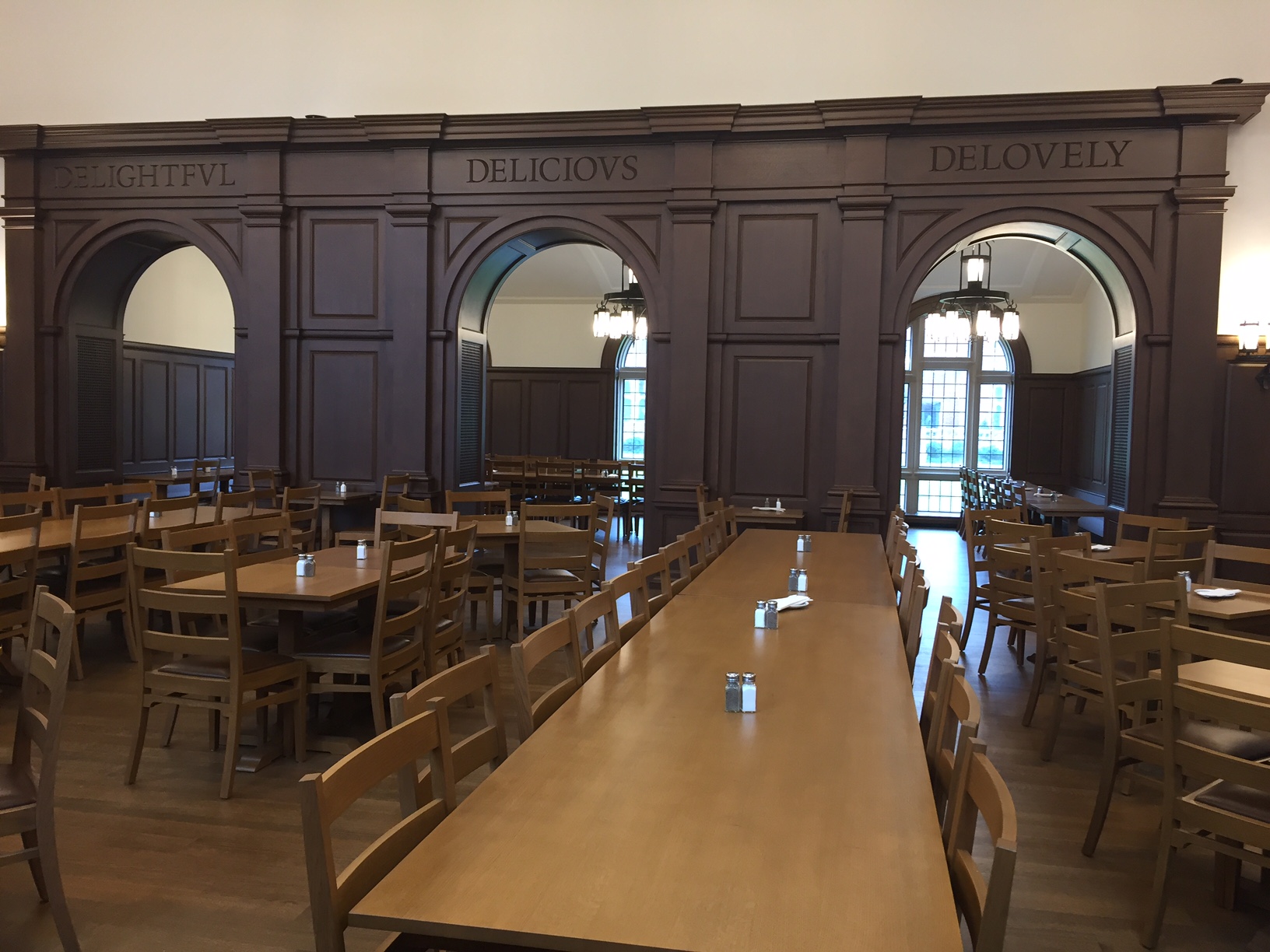
Inscription, Murray College Hall, Yale. Brian Meacham photo. 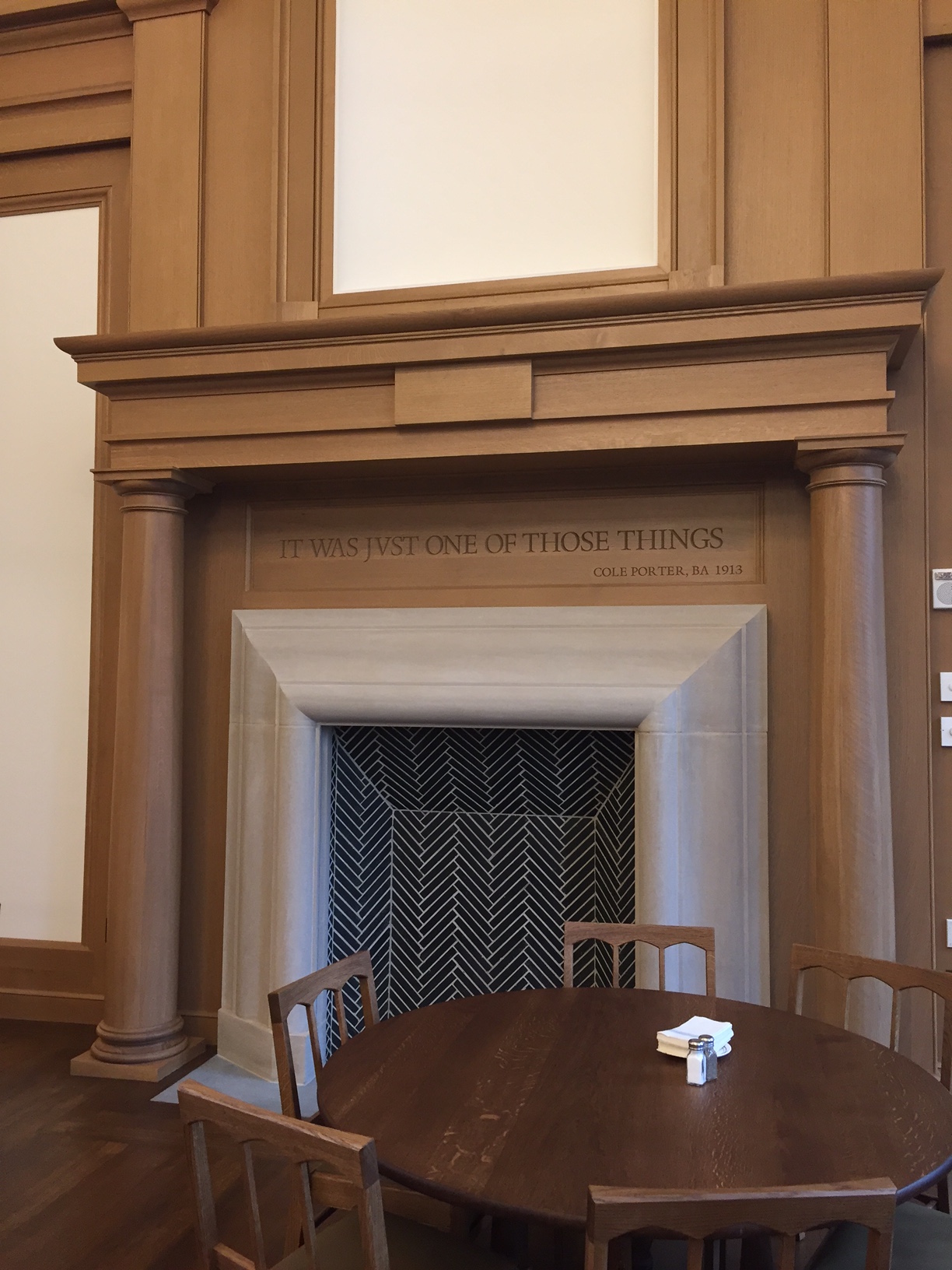
Fireplace, Franklin College Hall, Yale. Brian Meacham photo.
————————-
| ↑1 | Tricia McKeon, “New Class of 1967 Bunkhouse Supports Dartmouth’s Spirit of Adventure,” Alumni News (19 July 2017). |
|---|---|
| ↑2 | Dick Hoefnagel, “John Flude’s Medal,” Dartmouth College Library Bulletin (November 1991). |
The college could close the Country Club
The college is considering whether to shutter its historic Hanover Country Club.
Even if the college were to close the club, of course, it would never sell off the entire golf course. The golf course has been officially viewed as a “land bank” for future institutional development for at least 15 years (see the 2002 master plan pdf).
This website has proposed that if the south end of the golf course is to be developed, it should be built up with some density using “town” forms rather than as an extension of the grassy campus, irrespective of ownership (see posts of 2008 and 2012).
Whatever form it takes, the development of the south end of the golf course should not require the closure of the Country Club. The Club itself has planned since at least 2000 to move its clubhouse to Lyme Road, and one could imagine new holes being added to the east of the course, near the Rugby Clubhouse, or to the north, in the Fletcher Circle neighborhood, where residents have had concerns about groundwater contamination migrating from CRREL. If the college really needs the land near Dewey Field for more buildings, it should simply shift the golf course instead of destroying it.
Gilman entering decrepitude
School of Grok
The office of new Provost Carolyn Dever is launching two task forces, one of which is aimed at “evaluating the prospect of giving Dartmouth’s graduate and advanced studies programs a physical plant” (The Dartmouth of September 30; see also The Graduate Forum of October 3, The Dartmouth of October 7).
Dartmouth has operated a number of graduate programs for years. Most are attached to relevant undergraduate departments. Thus the creation of a freestanding school of graduate studies need not involve any expansion; it could be done as an administrative reorganization, and, in theory, it could even result in a streamlining of staff. Whether or not a grad studies building is a goal at the moment, however, a building seems likely. As far back as 2007 the unbuilt design (pdf page 9) for a freestanding Class of 1953 Commons included a Graduate Suite.
Maybe some part of the old hospital site is as good as any; maybe when Dana Library moves out of its temporary location in Home 57, that building could house the School of Graduate Studies. Maybe a new building for Dana could terminate the Berry Row axis and link the Medical School with the Graduate School, as the Murdough Center links Tuck and Thayer.
Of course all this growth became inevitable once the program/school adopted a coat of arms back in 2010.
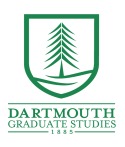
Report from the Radcliffe Observatory Quarter
Several posts here over the past few years have commented on the redevelopment of what’s called the Radcliffe Observatory Quarter in Oxford, comparing it to Hanover’s own hospital district north of Maynard.
Rafael Viñoly Architects devised a 2008 master plan for the area that appears in an aerial view before the makeover:
- The Oxford University Press building is visible at the right, outside the quarter.
- That church opposite the Press (St. Paul’s) was a coffee shop/bar called FREVD that served as an example here in the Rollins Chapel reuse post.
- Just beyond the church is the future site of the building of the Blavatnik School of Government (founded 2010, Wikipedia). Circle-in-a-square buildings do have a special history here, but even a person with some fondness for spaceship buildings could find something to quibble with in this project by Herzog & de Meuron.
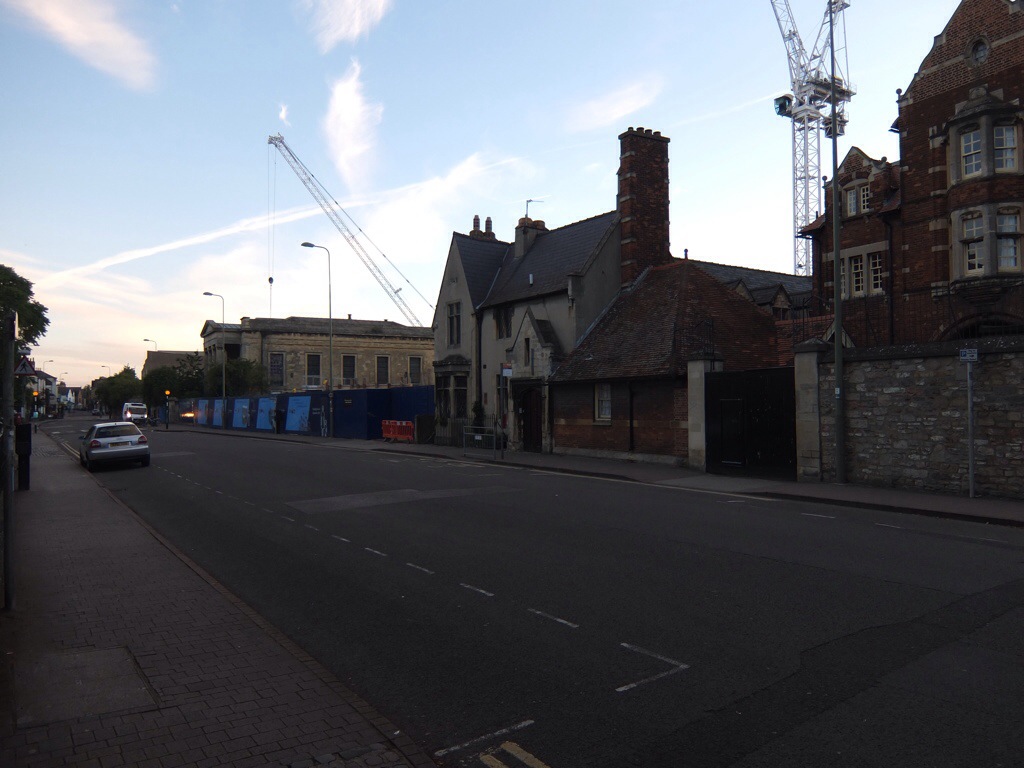
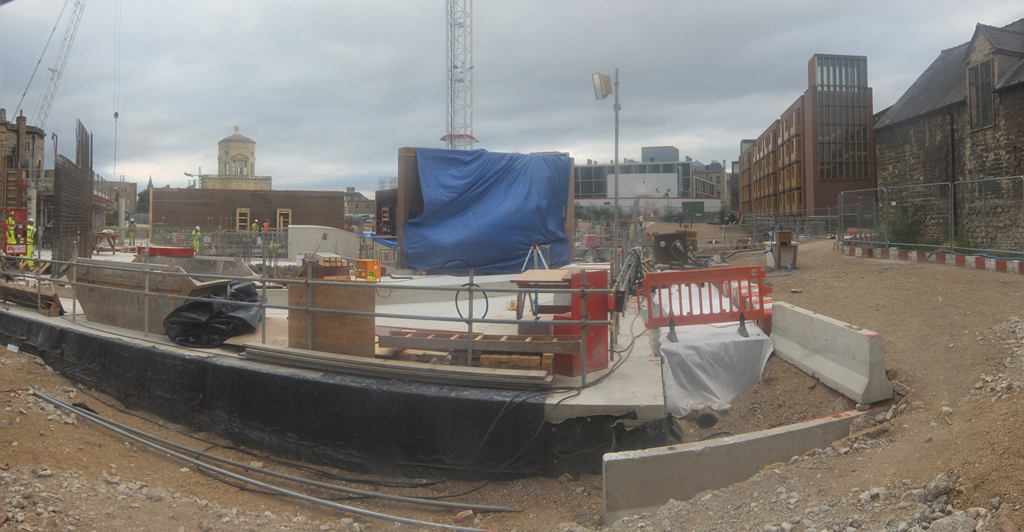
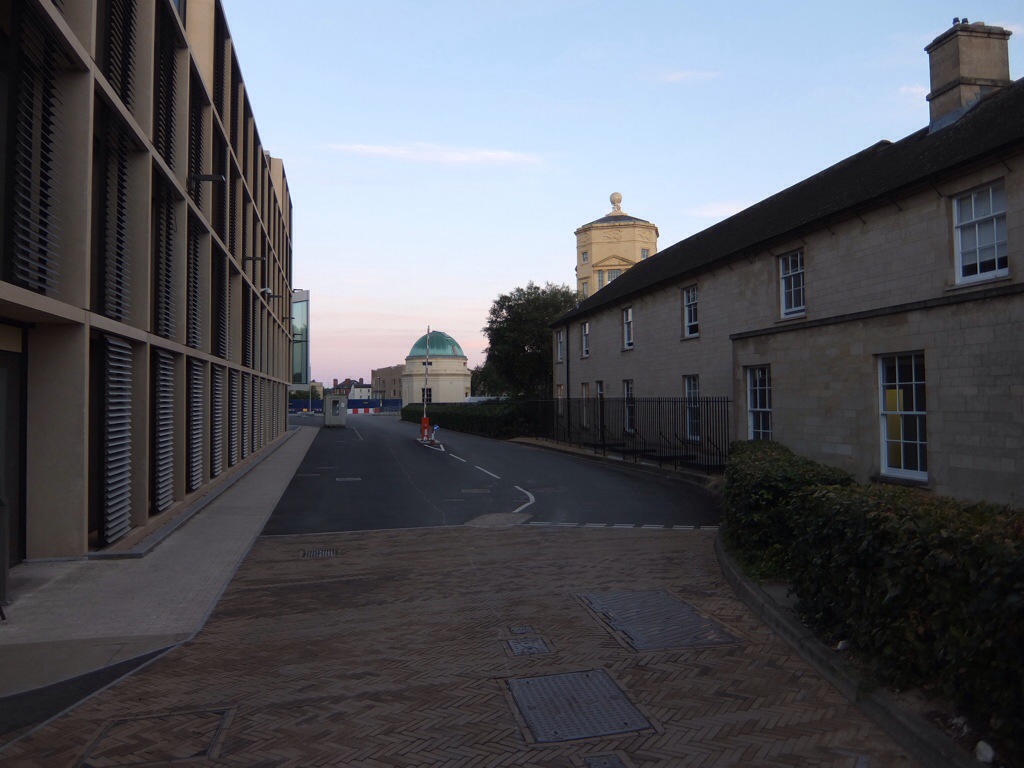
The broad approach taken by the university as developer is interesting: there was archeology beforehand (Neolithic ring ditches!) and during construction there was an artist in residence and a set of public art presentations.
—–
[Update 07.20.2014: View through hoarding added. Thanks to Hugin for panoramic image software.]
New surgical wing; other topics
-
The college recently unveiled a plaque announcing the Orozco Frescoes’ status as a National Historic Landmark (Dartmouth Now). No images yet.
-
Dartmouth Engineer has a story on the new Center for Surgical Innovation. This addition to DHMC is one of the few parts of the complex not designed by SBRA (post).
-
A Kendal news release on master planning refers to the acquisition of the Chieftain. A future expansion of the retirement center could make a neat feature out of the Chieftain’s rowing dock.
-
The New York Times has a story on the planned demolition of the Folk Art Museum to make way for an expansion of MOMA next door. (The architects of the Folk Art Museum, Tod Williams and Billie Tsien, are designing an expansion of Dartmouth’s Hood Museum that preserves and reuses Wilson Hall next door.)
-
Enjoy the retro poster (via Big Green Alert Daily) for round one of the Varsity Cup rugby tournament, held at the Rugby Clubhouse. Dartmouth won the match.
-
CurbedNY has a bit on the Guastavino family. The one grandly-scaled Guastavino-tiled space at Dartmouth, the surgical theatre at the old hospital, no longer exists, but the firm’s vault in the hospital’s one surviving wing remains on Rope Ferry Road. Also check out the entry vestibule of McNutt Hall, likely a Guastavino structure (post).
-
UPNE is listing a publication of a partner called Voice of the Åland Churches by Åsa Ringbom. How about that. Åland (Wikipedia) is an autonomous island province of Finland located in the Baltic partway to Sweden. It has its own stamps and a striking flag that reflect its largely Swedish ethnicity.
-
Dartmouth needs to name at least one building for the building’s architect. This is not an uncommon practice, although only one example comes to mind, the Norman Shaw Buildings at Parliament in London (Wikipedia; W&M’s main building was not designed by Christopher Wren). The designers who need recognition at Dartmouth are Charles A. Rich and Jens F. Larson. The bulk of the campus was created by these two College Architects in succession between about 1895 and 1939. The one building on which both architects did extensive work is the Heating Plant, which Rich built as a one-story building and Larson raised by one story. Maybe when the Heating Plant is taken over by the college museum, these artists can be credited and the building can be known as the Rich-Larson Wing of the Hood Museum of Art.
-
Brown started up its 250th anniversary celebration last month. Dartmouth’s ex-president Jim Yong Kim, a 1982 Brown graduate, gave a lecture at the Opening Celebration. The “Traditions” section of the 250th website explains that Brown chose the brown bear as its mascot in 1904 and in 1905 brought a live bear to a football game — the Dartmouth game — for the first time. Dartmouth won. (Brown doesn’t call the anniversary a “quartomillenium” or “sestercentenary” but a “semiquincentenary.”)
-
DUSA (Dartmouth Uniformed Service Alumni) has an informative page devoted to its symbols. As is traditional, the shield has the wavy lines representing the Connecticut River in the base. One wonders whether every organization, including the college, would benefit from depicting the River as a set of wavy bars thick enough to have their own colors, perhaps blue or even white (alternating with the green color of the field).
-
Interface: News and Information from Dartmouth Computing Services is back. One might recall the nice paper magazine iteration of Interface from the late 1990s.
-
The football team will wear an alternate helmet design at some point this fall, notes Tris Wykes in the Valley News. Perhaps influenced by trends in cars (Financial Times, Autoweek) or the Pro-Tec helmets worn by skateboarders or special operators, matte black seems to be gaining popularity in football. Examples are found at Cincinnati and Oregon; Missouri seems to have been an early proponent in 2009 with its Nike Pro Combat uniform (see Uniform Critics).
—–
Update 05.22.2014: Banwell architect Ingrid Nichols’s resume (pdf) states:
Banwell has joined forces with a national Kendal design architect, RLPS and together are completing a master plan for a new 20 acre abutting parcel they have recently purchased. We are also completing a master plan for their existing campus including: Additions for independent living, nursing, health center, fitness center (pool, locker rooms, exercise rooms and activity room).
BASIC at 50 and other items
- Work continues on the Williamson Translational Research Building at the hospital in Lebanon. Here is a notable tidbit about the building’s namesake donor, the late Dr. Peter Williamson ’58: he once owned the ultimate collector car, Lord Rothschild’s Bugatti Atlantic. Williamson’s car won the Pebble Beach Concours in 2003 and is now in the Mullin Automotive Museum.
- The Rauner Blog post on E.E. Just has a great old photo of Hallgarten. The building was built for the state ag school, known then as N.H.C.A.M.A., and its rear ell is the only part of any building from the campus to survive. The school later moved to Durham and became U.N.H., as its football website points out (via Big Green Alert). Of course, the most meaningful fact that relates to the football rivalry is that Dartmouth’s Memorial Field, indeed the entirety of its athletic complex west of Park Street, was built on one of the state farm fields. The students of the N.H.C.A.M.A. learned how to raise crops in the place where Dartmouth students now play football.
- A group called Project VetCare is buying a house in Hanover, apparently around 65-75 Lebanon Street, to provide housing for veterans, including students (The Dartmouth).
- Dartmouth Medicine has had a redesign by Bates Creative.
- Wouldn’t it be interesting if the U.S. had national food appellations (Wikipedia) beyond the grape-growing regions designated by the AVA? There simply is no equivalent to the geographical indications and traditional specialities of the EU (PDO, PGI, TSG), the AOC of France, or the DOC of Italy. Not all traditional foods are old — Birmingham Balti has been proposed for the list of U.K. foods given protected status, and farmed Scottish salmon is already listed.
- Kendal has demolished the Chieftain (Valley News).
- Crouching Spider is going away (Flickr).
- Dartmouth has talked about changing the name of the overall institution — the umbrella under which the undergraduate college and the graduate and professional schools operate — from Dartmouth College to Dartmouth University. The purpose would be to raise the school’s standing among observers, mostly outside the West, for whom “college” can mean a secondary school or lower school. A fascinating example of this renaming motive is found in Trinity College Dublin, another school that has landed outside the top 125 in the Times World University Rankings. Trinity was founded in 1592 (Wikipedia) as a constituent college of the University of Dublin. What makes Trinity odd is that the University never added any other colleges — Trinity is all there is, and yet the university administration survives, under its own name. Trinity’s rebranding now proposes to replace “Trinity College Dublin” with “Trinity College, University of Dublin.” Oh well; at least the “improved” name seems historically-grounded and technically accurate. Brian M. Lucey argues against it in a blog post, and another post. The real controversy in the rebranding involves the coat of arms:
- Although the Irish Times claims that the Bible is being removed from Trinity’s arms, that does not necessarily appear to be the case. According to an informative paper by Professor John Scattergood (pdf, via Brian M. Lucey), the arms, as formally granted in 1901, require “a Bible closed, clasps to the dexter.” The rebranding includes a new, stylized version of the coat of arms that substitutes an open book, something that easily could be called “a Bible open.” Visually, neither one of the shields identifies the book to the ordinary observer. The changes in colors are all part of the stylization and do no violence to the underlying historic coat of arms. (The University of Dublin obtained its own arms in 1862, and they contain an open book, incidentally.)
- UNH has picked a new logo, a shield designed by Chermayeff & Geismar & Haviv. This shield is not one of the three shields that the firm initially proposed last year (post). Although a couple of those first ideas were intriguing, students and alumni were not pleased. The new identity guide (pdf) notes that “The specific blue color has been made a bit brighter than the past version.”
- Just for your information, the maximum number of effective footnotes in a Word document (Word:Mac 2008) is 32,768. Notes above that number fail gracefully: they still work but are numbered incorrectly, all sharing either the number 32768 or one of a few numbers after that.
- The school’s Flickr feed has a nice set of historic photos titled “BASIC at 50: The Democratization of Computing.” It is especially gratifying to see the buildings identified: the College Hall basement, Kiewit, and so on. (In the lower right corner of another view of Kiewit is a glimpse of someone who could have been a predecessor of Usenet celebrity and campus character Ludwig Plutonium.)
- This fantastic photo of President Kemeny with his BASIC license plate was taken in the parking lot east of Bradley/Gerry, it appears, and has the rear addition of the Church of Christ for a backdrop (somewhat near this present-day Google Street View).
- From an article in The Dartmouth on planning VP Lisa Hogarty: “The biggest change in the College’s capital budget, she said, will come from the proposed expansion to the Thayer School of Engineering.” See the sample master plans of Koetter Kim (post) and Beyer Blinder Belle (post) and the Thayer press release on President Hanlon’s 2013 expansion announcement.
- The news that a family had donated $100m to support Hanlon initiatives makes one think of the Harkness gifts to create “residential colleges” at Harvard and later Yale, but reading The Dartmouth, one learns:
Mastanduno said this gift represents a significant departure from past donations, which have tended to focus on capital infrastructure.
“This isn’t about bricks and mortar,” he said. “It’s about the core academic mission of Dartmouth.”
—–
[Update 04.17.2014: Broken link to Mullin removed, Kendal spelling corrected.]
The Geisel School’s identity guidelines and their breaking
The Geisel School’s thorough Visual Identity and Naming Conventions (pdf) state:
FIRST REFERENCE:
+ The Audrey and Theodor Geisel School of Medicine at Dartmouth
OR
The Geisel School of Medicine at Dartmouth
Although the web version of the medical school magazine for Fall ’13 has no logo graphics on its table of contents, it describes itself in the masthead as “The magazine of the Geisel School of Medicine at Dartmouth”. The website of the school itself features this graphic:

So far so good. This form of the name complies with the conventions.
But when one views the pdf version of the same magazine table of contents, one sees this:

The school’s Youtube channel also follows this new form. Not only does this reordering violate the first rule of the Guidelines, it violates the second:
SECOND AND SUBSEQUENT REFERENCES:
+ Geisel School of Medicine at Dartmouth
+ Dartmouth’s Geisel School of Medicine
+ Geisel School of Medicine
This transition was first spotted by Joe Asch at Dartblog.
